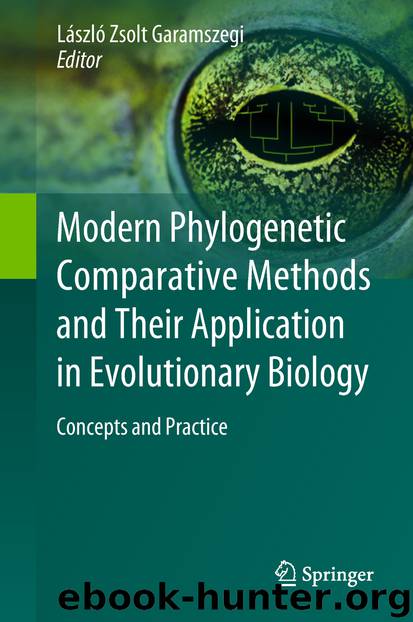Modern Phylogenetic Comparative Methods and Their Application in Evolutionary Biology by László Zsolt Garamszegi

Author:László Zsolt Garamszegi
Language: eng
Format: epub
Publisher: Springer Berlin Heidelberg, Berlin, Heidelberg
10.7 Further Issues and Advanced Topics
10.7.1 Stochastic Character Mapping and Alternative Ways to Model Discrete Characters
A further extension of this kind of model-based Bayesian approach is to employ the inferred rate of change to explicitly reconstruct the changes a character undergoes over the whole phylogeny, using a technique known as stochastic character mapping (SCM) (Bollback 2006; Huelsenbeck et al. 2003). We saw earlier how this was traditionally done using parsimony techniques, and character histories can also be approximated with likelihood methods by reconstructing likely states at ancestral nodes and noting where character changes seem to occur between these nodes. SCM goes one step further, by producing a posterior sample of ancestral states and likely changes along the branch, and unlike previous techniques, SCM can show multiple changes along a branch. By explicitly considering the rate of change and branch lengths in these character histories, SCM makes more use of the information available. In addition to this kind of descriptive application, SCM can also be used to detect signatures of positive selection in genetic data and provides an alternative assessment of co-evolution based on the amount of time traits spend together in certain states19. Furthermore, the output from SCM analyses can be used in further analyses that examine how other traits are evolving, e.g. variation in rates of change of a continuous character (O’Meara et al. 2006) or the different selective regimes in OU models (Beaulieu et al. 2012).
Here, we have focussed on the Markov chain approach to modelling the evolution of discrete characters. However, it should be noted that other methods are also possible. For example, logistic regression (i.e. a regression analysis in which the dependent variable is a categorical variable) can be adapted to incorporate the variance–covariance structure derived from the phylogenetic associations between species (Ives and Garland 2010; Ives and Garland Chap. 9 this volume). Also, categorical traits can be modelled as if they are related to a continuously varying underlying scale (the liability); above a certain value, the trait takes one form, while below this value, it takes another form, etc. (Felsenstein 2005, 2012). One advantage of these methods is that they allow us to examine the covariation between more than just two binary characters.20 On the other hand, they do not allow us to make direct inferences about the order in which traits change in the manner that Pagel’s method does. As with all investigations, the particular method that should be employed will depend on the question being asked and the data available to answer it.
Download
This site does not store any files on its server. We only index and link to content provided by other sites. Please contact the content providers to delete copyright contents if any and email us, we'll remove relevant links or contents immediately.
| Cell Biology | Developmental Biology |
| Entomology | Marine Biology |
| Microbiology | Molecular Biology |
| Biostatistics |
Sapiens: A Brief History of Humankind by Yuval Noah Harari(13052)
The Tidewater Tales by John Barth(12029)
Do No Harm Stories of Life, Death and Brain Surgery by Henry Marsh(6336)
Mastermind: How to Think Like Sherlock Holmes by Maria Konnikova(6235)
The Thirst by Nesbo Jo(5785)
Why We Sleep: Unlocking the Power of Sleep and Dreams by Matthew Walker(5641)
Sapiens by Yuval Noah Harari(4537)
Life 3.0: Being Human in the Age of Artificial Intelligence by Tegmark Max(4507)
The Longevity Diet by Valter Longo(4445)
The Rules Do Not Apply by Ariel Levy(3905)
The Immortal Life of Henrietta Lacks by Rebecca Skloot(3826)
The Body: A Guide for Occupants by Bill Bryson(3800)
Why We Sleep by Matthew Walker(3771)
Animal Frequency by Melissa Alvarez(3755)
Yoga Anatomy by Kaminoff Leslie(3701)
Barron's AP Biology by Goldberg M.S. Deborah T(3631)
The Hacking of the American Mind by Robert H. Lustig(3579)
All Creatures Great and Small by James Herriot(3515)
Yoga Anatomy by Leslie Kaminoff & Amy Matthews(3395)
